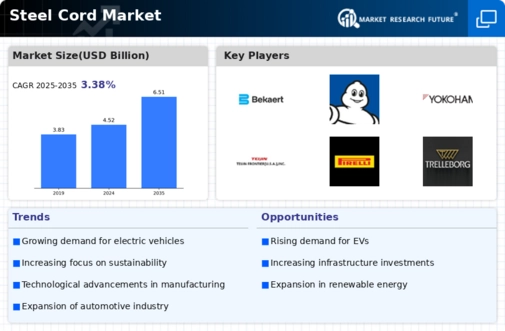Market Growth Projections
The Global Steel Cord Market Industry is poised for substantial growth, with projections indicating a market value of 4.52 USD Billion in 2024 and a potential increase to 6.51 USD Billion by 2035. This growth trajectory suggests a compound annual growth rate (CAGR) of 3.38% from 2025 to 2035. Such figures reflect the increasing reliance on steel cords in tire manufacturing, driven by advancements in technology, regulatory standards, and the overall expansion of the automotive sector. The market dynamics indicate a favorable environment for stakeholders, as the demand for high-performance tires continues to rise, reinforcing the importance of steel cords in meeting these evolving needs.
Increasing Demand for Tires
The Global Steel Cord Market Industry experiences heightened demand driven primarily by the tire manufacturing sector. As global vehicle production continues to rise, the need for high-performance tires, which utilize steel cords for enhanced durability and safety, becomes increasingly apparent. In 2024, the market is projected to reach 4.52 USD Billion, reflecting the robust growth of the automotive industry. This trend is expected to persist, with the market anticipated to expand to 6.51 USD Billion by 2035, indicating a compound annual growth rate (CAGR) of 3.38% from 2025 to 2035. Such growth underscores the critical role of steel cords in meeting the evolving requirements of modern tires.
Growth in the Automotive Sector
The Global Steel Cord Market Industry is significantly influenced by the expansion of the automotive sector. As emerging economies experience rapid urbanization and increased disposable incomes, the demand for vehicles rises correspondingly. This trend is particularly evident in regions such as Asia-Pacific, where automotive production is surging. The steel cord market is expected to benefit from this growth, as steel cords are essential components in tire manufacturing. With projections indicating a market value of 4.52 USD Billion in 2024, the industry's trajectory appears promising. By 2035, the market could reach 6.51 USD Billion, driven by the automotive sector's continuous evolution and the need for high-quality tires.
Sustainability Trends in Manufacturing
Sustainability trends are becoming increasingly prominent within the Global Steel Cord Market Industry. Manufacturers are recognizing the importance of environmentally friendly practices and the need to reduce their carbon footprint. This shift is leading to the adoption of sustainable materials and processes in steel cord production. Companies are investing in research and development to create eco-friendly alternatives that do not compromise on performance. As consumers become more environmentally conscious, the demand for sustainable products is likely to rise, influencing purchasing decisions in the automotive sector. This trend may drive innovation and create new market opportunities, ultimately contributing to the growth of the steel cord market.
Technological Advancements in Manufacturing
Technological innovations within the Global Steel Cord Market Industry are pivotal in enhancing production efficiency and product quality. The introduction of advanced manufacturing techniques, such as automation and precision engineering, allows for the production of steel cords that meet stringent performance standards. These advancements not only improve the tensile strength and fatigue resistance of steel cords but also reduce production costs. As manufacturers adopt these technologies, they are likely to capture a larger market share, thereby contributing to the overall growth of the industry. The continuous evolution of manufacturing processes may lead to further enhancements in product offerings, aligning with the increasing demands of tire manufacturers.
Regulatory Standards and Safety Requirements
The Global Steel Cord Market Industry is shaped by stringent regulatory standards and safety requirements imposed on tire manufacturing. Governments worldwide are increasingly mandating higher safety and performance benchmarks for tires, which necessitates the use of high-quality materials, including steel cords. These regulations aim to enhance road safety and reduce accidents, thereby driving demand for advanced tire technologies. Manufacturers are compelled to innovate and improve their products to comply with these standards, which in turn fuels growth within the steel cord market. As safety regulations evolve, the industry is likely to witness a shift towards more durable and reliable tire solutions, further solidifying the role of steel cords.












